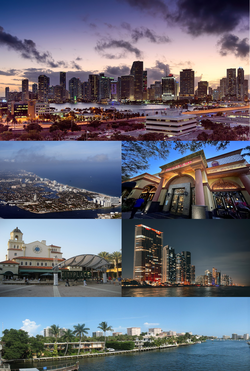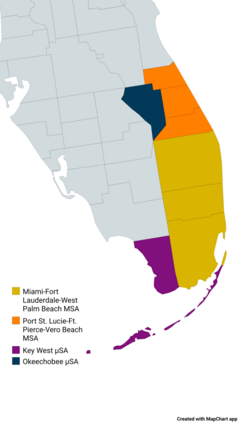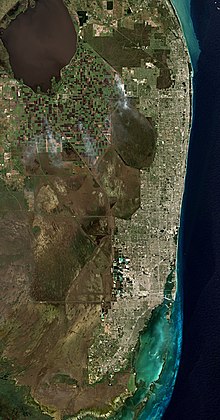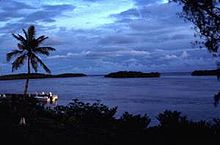
A | B | C | D | E | F | G | H | CH | I | J | K | L | M | N | O | P | Q | R | S | T | U | V | W | X | Y | Z | 0 | 1 | 2 | 3 | 4 | 5 | 6 | 7 | 8 | 9
Miami metropolitan area
Miami–Fort Lauderdale–West Palm Beach, FL Metropolitan Statistical Area[1] | |
|---|---|
 From top (left to right): Greater Downtown Miami, Fort Lauderdale, Sawgrass Mills, The Square at West Palm Beach, Miami Beach, and Boca Raton | |
 Location of the Miami metropolitan area's four primary components in Florida | |
| Coordinates: 26°8′N 80°12′W / 26.133°N 80.200°W | |
| Country | |
| State | |
| Core city | |
| Principal cities[1] | |
| Area | |
| • Land | 6,137 sq mi (15,890 km2) |
| Highest elevation | Jupiter 53 ft (16.2 m) |
| Lowest elevation | Atlantic Ocean 0 ft (0 m) |
| Population | |
| • Total | 6,138,333 |
| • Estimate (2023)[3] | 6,183,199 |
| • Rank | 9th in the United States 1st in Florida |
| • Density | 1,000.38/sq mi (386.37/km2) |
| GDP | |
| • MSA | $483.755 billion (2022) |
| Time zone | UTC−05:00 (Eastern Standard Time) |
| • Summer (DST) | UTC−04:00 (Eastern Daylight Time) |
The Miami metropolitan area, also known as South Florida, SoFlo, SoFla, the Gold Coast, the Tri-County Area, or Greater Miami, and officially the Miami–Fort Lauderdale–West Palm Beach Metropolitan Statistical Area, is a coastal metropolitan area in southeastern Florida. It is the ninth-largest metropolitan statistical area (MSA) in the United States, the fifth-largest metropolitan area in the Southern United States, and the largest metropolitan area in Florida. With a population of 6.18 million,[3] its population exceeds 31 of the nation's 50 states as of 2023. It comprises the three most populated counties in the state, Miami-Dade County, Broward County, and Palm Beach County, which rank as the first, second, and third-most populous counties in the state, respectively. Miami-Dade County, with 2,701,767 people in 2020, is the seventh-most populous county in the United States.
Miami is the region's financial and cultural core and most populous city. Other principal cities, as defined by the Office of Management and Budget, include Fort Lauderdale, West Palm Beach, Pompano Beach, Boca Raton, Sunrise, Deerfield Beach, Miami Beach, Kendall, Doral, Delray Beach, Jupiter, and Palm Beach Gardens.[1] The Miami metropolitan area is part of the larger South Florida region of the state, which also includes the Everglades and the Florida Keys.
With 1,279.2 sq mi (3,313 km2) of urban landmass, the Miami metropolitan area also is one of the world's most populous urban agglomerations.
South Florida is largely confined to a strip of land between the Atlantic Ocean and Everglades, and Miami's urbanized area is about 100 miles (160 km) long (north to south) and at most 20 miles (32 km) east to west; in some areas, its east to west width is only 5 miles (8 km). The Miami metropolitan statistical area is the second-longest urbanized area in the United States behind the New York metropolitan area.[5] It was the eighth-most densely populated urbanized area in the United States as of the 2000 census.[6]
As of the 2020 census, the Miami-Fort Lauderdale urbanized area had a land area of 1,244.18 square miles (3,222.4 km2), with a population of 6,077,522, for a population density of 4,884.78 inhabitants per square mile (1,886.02/km2). The Miami metropolitan area also had one urban cluster (UC) as of the 2020 census, which is not part of the Miami urbanized area. The Belle Glade urban cluster had a population of 23,009, area of 7.21 square miles (18.7 km2) and population density of 3,191.41 inhabitants per square mile (1,232.21/km2).[7] Miami, the largest city in the metropolitan area, had population density of over 10,000/sq mi (more than 3,800/km2) in 2000.[8][9] The Miami Urbanized Area was the fourth-largest urbanized area in the United States in the 2010 census.
The most notable colleges and universities in the Miami metropolitan area include Florida Atlantic University, Florida International University, Nova Southeastern University, and the University of Miami. The region also has three community colleges, Broward College, Miami Dade College, and Palm Beach State College. Some of these institutions, such as Florida International University and Miami Dade College, make up some of the largest institutions of higher learning in the United States.[10]
Definitions
Miami metropolitan area

As of 2023[update], the Miami metropolitan area is defined by the U.S. Office of Management and Budget as the Miami-Fort Lauderdale-West Palm Beach Metropolitan Statistical Area (MSA),[1] with a 2020 population of 6,138,333. The MSA is made up of three "metropolitan divisions" :
- Miami-Miami Beach-Kendall Metropolitan Division, coterminous with Miami Dade County (2020 population 2,701,767).
- Fort Lauderdale-Pompano Beach-Sunrise Metropolitan Division, coterminous with Broward County (2020 population 1,944,375).
- West Palm Beach-Boca Raton-Delray Beach Metropolitan Division, coterminous with Palm Beach County (2020 population 1,492,191).[11]
The MSA is the second most populous metropolitan area in the Southeastern United States and has an area of 6,137 sq. mi (15,890 km2).
The original MSA for Miami, as defined by the OMB, included only Dade County (now Miami-Dade County). By 1995, the Miami-Hialeah and Fort Lauderdale-Hollywood-Pompano Beach MSAs had been merged into the Miami-Fort Lauderdale Consolidated MSA, consisting of the Miami Primary MSA (Dade County) and the Fort Lauderdale Primary MSA (Broward County).[12] In 2003, the West Palm Beach-Boca Raton-Boynton Beach MSA was merged with the consolidated MSA to form the Miami-Fort Lauderdale-Miami Beach Metropolitan Statistical Area, consisting of: the Fort Lauderdale-Pompano Beach-Deefield Beach Metropolitan Division (Broward County), the Miami-Miami Beach-Kendall Metropolitan Division (Miami-Dade County), and the West Palm Beach-Boca Raton-Boynton Beach Metropolitan Division (Palm Beach County).[13]
Miami-Port Saint Lucie-Fort Lauderdale Combined Statistical Area
The Census Bureau also defines a wider commercial region based on commuting patterns, the Miami-Port Saint Lucie-Fort Lauderdale Combined Statistical Area (CSA), with a population of 6,887,655 in 2020.
As of 2023[update], the CSA consists of three component metropolitan statistical areas (MSAs) and one Micropolitan statistical area (μSA):
- The Miami-Fort Lauderdale-West Palm Beach MSA (2020 pop. 6,138,333)
- The Port Saint Lucie MSA (2020 pop. 486,660), consisting of:
- Martin County (2020 pop. 158,431)p. 28
- Saint Lucie County (2020 pop. 329,226)p. 28
- The Sebastian-Vero Beach-West Vero Corridor MSA, coterminous with Indian River County (2020 pop. 159,788)
- The Key West-Key Largo μSA, coterminous with Monroe County (2020 pop. 82,874).
- The Okeechobee μSA, coterminous with Okeechobee County.[14][11]
When the CSA was defined in 2013, it included the Okeechobee μSA, but not the Key West μSA. In 2018 the Okeechobee μSA was removed from the CSA and the Key West μSA was added. The Okeechobee μSA was re-added to the CSA in 2023.[15][16][14]
Gold Coast
The Miami metropolitan area is frequently named the "Gold Coast" in convention with Florida's other coast regions, including the Space Coast, Treasure Coast, Sun Coast, Nature Coast, Forgotten Coast, Emerald Coast, Fun Coast, and First Coast. Like several of the others, it seems to have originated at the time the area first saw major growth. One of the best known of Florida's vernacular regions, the name is a reference to the wealth and ritzy tropical lifestyle that characterizes the area.[17][18]
Climate and geography
Climate

South Florida/Miami metropolitan area has a tropical climate, similar to the climate found in much of the Caribbean. It is the only metropolitan area in the 48 contiguous states that falls under that category. More specifically, it generally has a tropical monsoon climate (Köppen climate classification, Am).[19] The South Florida metropolis sees most of its rain in the summer (wet season) and is quite dry in the winter (dry season). The wet season, which is hot and humid, lasts from May to October, when daily thunderstorms and passing weak tropical lows bring downpours during the late afternoon. The dry season often starts in late October and runs through late April. During the height of the dry season from February through April, South Florida is often very dry, and often brush fires and water restrictions are an issue. At times cold fronts can make it all the way down to South Florida and provide some modest rainfall in the dry season. The hurricane season largely coincides with the wet season.[20]
In addition to its sea-level elevation, coastal location and position near the Tropic of Cancer and the Caribbean, the area owes its warm, humid climate to the Gulf Stream, which moderates climate year-round. A typical summer day does not see temperatures below 75 °F (24 °C). Temperatures in the high 80s to low 90s (30–35 °C) accompanied by high humidity are often relieved by afternoon thunderstorms or a sea breeze that develops off the Atlantic Ocean, which then allow lower temperatures, although conditions still remain very muggy.
During winter, dry air often dominates as dew points are often very low. Average daily high temperatures across South Florida during the winter are around 74–77 °F (23–25 °C). Although daily highs can sometimes reach 82–85 °F (28–29 °C) even in January and February. Daily low temperatures during the winter are generally around 55–63 °F (13–17 °C). Each winter, cold fronts occasionally make their way down to the northern Bahamas and South Florida. As a result, daytime high temperatures in South Florida may only reach around 65 °F (18 °C) or cooler. When this occurs low temperatures can dip into the 40s during the early morning hours before quickly warming-up toward late morning/early afternoon. It is rare for temperatures to drop below 40 °F (4 °C), however, low temperatures at or around 35 °F (2 °C) have occurred some years. South Florida only experiences these cold spells about twice each winter and they typically only last a day or two before temperatures return to the mid 70s. On average South Florida is frost-free, although there can be a light frost in the inland communities about once every decade.
Hurricane season officially runs from June 1 through November 30, although hurricanes can develop outside that period. The most likely time for South Florida to be hit is during the peak of the Cape Verde season, mid-August through the end of September.[21] Due to its location between two major bodies of water known for tropical activity, South Florida is also statistically the most likely major area to be struck by a hurricane in the world, trailed closely by Nassau, Bahamas, and Havana, Cuba. Many hurricanes have affected the metropolis, including Betsy in 1965, Andrew in 1992, Irene in 1999, Hurricanes Katrina and Wilma in 2005, and Irma in 2017. In addition, a tropical depression in October 2000 passed over the city, causing record rainfall and flooding. Locally, the storm is credited as the No Name Storm of 2000, though the depression went on to become Tropical Storm Leslie upon entering the Atlantic Ocean.
| Climate data for West Palm Beach Airport, Florida (1981–2010 normals,[22] extremes 1888–present) | |||||||||||||
|---|---|---|---|---|---|---|---|---|---|---|---|---|---|
| Month | Jan | Feb | Mar | Apr | May | Jun | Jul | Aug | Sep | Oct | Nov | Dec | Year |
| Mean daily maximum °F (°C) | 75.2 (24.0) |
76.3 (24.6) |
80.0 (26.7) |
84.1 (28.9) |
87.0 (30.6) |
90.7 (32.6) |
92.0 (33.3) |
91.3 (32.9) |
88.3 (31.3) |
84.3 (29.1) |
82.3 (27.9) |
76.7 (24.8) |
84.3 (29.1) |
| Mean daily minimum °F (°C) | 57.4 (14.1) |
58.6 (14.8) |
61.7 (16.5) |
65.0 (18.3) |
71.1 (21.7) |
75.0 (23.9) |
75.2 (24.0) |
75.4 (24.1) |
74.3 (23.5) |
70.9 (21.6) |
63.4 (17.4) |
60.0 (15.6) |
66.8 (19.3) |
| Average rainfall inches (mm) | 2.18 (55) |
2.09 (53) |
2.05 (52) |
2.03 (52) |
5.76 (146) |
9.02 (229) |
9.27 (235) |
9.83 (250) |
9.93 (252) |
9.57 (243) |
5.07 (129) |
2.27 (58) |
60.35 (1,533) |
| Average rainy days (≥ 0.01 in) | 7.8 | 6.7 | 5.0 | 5.8 | 14.1 | 16.0 | 18.1 | 19.0 | 16.7 | 17.1 | 10.2 | 7.1 | 132.6 |
| Source: NOAA[23][24] | |||||||||||||
| Climate data for Fort Lauderdale Int'l Airport, Florida (1981–2010 normals, extremes 1912–present) | |||||||||||||
|---|---|---|---|---|---|---|---|---|---|---|---|---|---|
| Month | Jan | Feb | Mar | Apr | May | Jun | Jul | Aug | Sep | Oct | Nov | Dec | Year |
| Mean daily maximum °F (°C) | 75.5 (24.2) |
76.7 (24.8) |
78.5 (25.8) |
82.9 (28.3) |
85.6 (29.8) |
89.8 (32.1) |
91.9 (33.3) |
90.5 (32.5) |
88.8 (31.6) |
85.8 (29.9) |
81.0 (27.2) |
76.9 (24.9) |
83.3 (28.5) |
| Mean daily minimum °F (°C) | 59.0 (15.0) |
60.5 (15.8) |
63.4 (17.4) |
66.9 (19.4) |
72.0 (22.2) |
74.4 (23.6) |
75.9 (24.4) |
75.8 (24.3) |
75.2 (24.0) |
71.8 (22.1) |
65.7 (18.7) |
61.3 (16.3) |
67.7 (19.8) |
| Average rainfall inches (mm) | 3.63 (92) |
2.96 (75) |
3.36 (85) |
2.89 (73) |
4.65 (118) |
10.16 (258) |
5.98 (152) |
7.44 (189) |
8.59 (218) |
6.82 (173) |
3.24 (82) |
2.46 (62) |
62.18 (1,579) |
| Average rainy days (≥ 0.01 in) | 5.0 | 6.1 | 6.9 | 5.4 | 8.8 | 15.9 | 15.9 | 15.7 | 15.8 | 10.6 | 8.1 | 8.1 | 122.3 |
| Source: [25][26][27] | |||||||||||||
